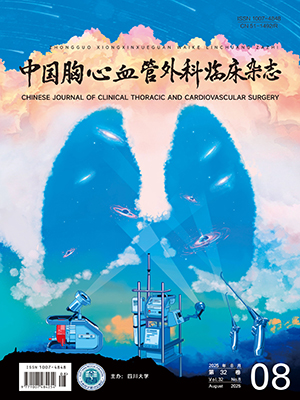| 1. |
Stathopoulos I, Kossidas K, Panagopoulos G, et al. Cardiac tamponade complicating coronary perforation during angioplasty:short-term outcomes and long-term survival. J Invasive Cardiol, 2013, 25(10):486-491.
|
| 2. |
Seshadri N, Whitlow PL, Acharya N, et al. Emergency coronary artery bypass surgery in the contemporary percutaneous coronary intervention era. Circulation, 2002, 106(18):2346-2350.
|
| 3. |
Hendry C, Fraser D, Eichhofer J, et al. Coronary perforation in the drug-eluting stent era:incidence, risk factors, management and outcome:the UK experience. EuroIntervention, 2012, 8(1):79-86.
|
| 4. |
Rogers JH, Lasala JM. Coronary artery dissection and perforation complicating percutaneous coronary intervention. J Invasive Cardiol, 2004, 16(9):493-499.
|
| 5. |
Darwazah AK, Islim I, Hanbali B, et al. Emergency coronary artery bypass surgery after failed percutaneous coronary intervention. J Cardiovasc Surg (Torino), 2009, 50(6):795-800.
|
| 6. |
Schrale RG, van Gaal W, Channon KM, et al. Long-term outcomes of percutaneous coronary intervention for unprotected left main coronary artery disease. Int J Cardiol, 2008, 130(2):185-189.
|
| 7. |
Koskinas KC, Chatzizisis YS, Antoniadis AP, et al. Role of endothelial shear stress in stent restenosis and thrombosis:pathophysiologic mechanisms and implications for clinical translation. J Am Coll Cardiol, 2012, 59(15):1337-1349.
|
| 8. |
Gruntzig AR, Senning A, Siegenthaler WE. Nonoperative dilatation of coronary-artery stenosis:percutaneous transluminal coronary angioplasty. N Engl J Med, 1979, 301(2):61-68.
|
| 9. |
De Luca G. Glycoprotein Ⅱb-Ⅲa inhibitors. Cardiovasc Ther, 2012, 30(5):e242-e254.
|
| 10. |
Valgimigli M, Tebaldi M, Borghesi M, et al. Two-year outcomes after first- or second-generation drug-eluting or bare-metal dtent implantation in all-comer patients undergoing percutaneous coronary intervention:a pre-specified analysis from the PRODIGY study (PROlonging dual antiplatelet treatment after grading stentinduced intimal hyperplasia study). JACC Cardiovasc Interv, 2014, 7(1):20-28.
|
| 11. |
Ellis SG, Weintraub W, Holmes D, et al. Relation of operator volume and experience to procedural outcome of percutaneous coronary revascularization at hospitals with high interventional volumes. Circulation, 1997, 95(11):2479-2484.
|
| 12. |
Stolker JM, Allen DS, Cohen DJ, et al. Comparison of procedural complications with versus without interventional cardiology fellows-in-training during contemporary percutaneous coronary intervention. Am J Cardiol, 2014, 113(1):44-48.
|
| 13. |
Roy P, de Labriolle A, Hanna N, et al. Requirement for emergent coronary artery bypass surgery following percutaneous coronary intervention in the stent era. Am J Cardiol, 2009, 103(7):950-953.
|
| 14. |
吕树铮, 宋现涛, 陈韵岱, 等. 中国内地2005 年度经皮冠状动脉介入治疗登记调查研究结果初步分析. 中华心血管病杂志, 2006, 34(11):966-970.
|
| 15. |
Jaffe R, Strauss BH. Late and very late thrombosis of drug-eluting stents:evolving concepts and perspectives. J Am Coll Cardiol, 2007, 50(2):119-127.
|
| 16. |
McEntegart MB, Kirtane AJ, Cristea E, et al. Intraprocedural thrombotic events during percutaneous coronary intervention in Patients with non-ST-segment elevation acute coronary syndromes are associated with adverse outcomes. Analysis from the ACUITY (Acute Catheterization and Urgent Intervention Triage Strategy) trial. J Am Coll Cardiol, 2012, 59(20):1745-1751.
|
| 17. |
Rezkalla SH, Kloner RA. Coronary no-reflow phenomenon:from the experimental laboratory to the cardiac catheterization laboratory. Catheter Cardiovasc Interv, 2008, 72(7):950-957.
|
| 18. |
Muller O, Trana C, Eeckhout E. Myocardial no-reflow treatment. Curr Vasc Pharmacol, 2013, 11(2):278-285.
|
| 19. |
Srikanth S, Ambrose JA. Pathophysiology of coronary thrombus formation and adverse consequences of thrombus during PCI. Curr Cardiol Rev, 2012, 8(3):168-176.
|
| 20. |
Kiernan TJ, Yan BP, Ruggiero N, et al. Coronary artery perforations in the contemporary interventional era. J Interv Cardiol, 2009, 22(4):350-353.
|




